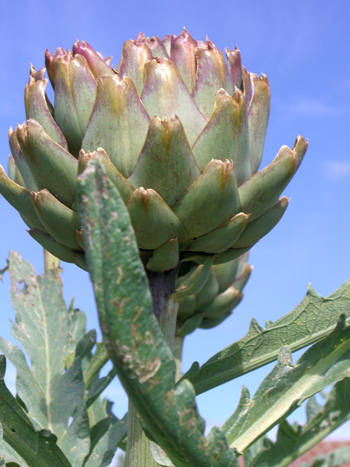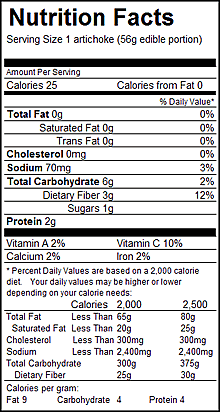Contents:
Common Names | Parts Usually Used | Plant(s) & Culture | Where Found | Medicinal Properties
Legends, Myths and Stories | Uses | Formulas or Dosages | Nutrient Content | How Sold | Resource Links | Bibliography
Scientific Names

- Cynara scolymus L.
- Composite family
Common Names
- Garden artichoke
- Globe artichoke
Parts Usually Used
Flower heads, leaves, root
Back to Top
Description of Plant(s) and Culture

Artichoke is a perennial plant; its tuberous root produces a stem from
Back to Top
Where Found
Grows in the Mediterranean area and the Canary Islands and is widely cultivated elsewhere as a food plant.
Back to Top
Medicinal Properties
Cholagogue, diuretic, tonic
Back to Top
Legends, Myths and Stories
The flower or head of the artichoke, commonly known as the heart, is reputed to be an aphrodisiac, although this claim has never been scientifically proven. Through the years, various studies worldwide have shown that people’s blood cholesterol levels dropped after eating artichoke. In fact, an anticholesterol drug called cynara is derived from this herb. In 1940, a study is Japan showed that artichoke not only reduced cholesterol but it also increased bile production by the liver and worked as a good diuretic.
Native Americans of the Missouri River Valley region cultivated artichokes along with the squash, beans, corn, etc.
Back to Top
Uses
Extracts of the leaves and root are helpful in arteriosclerosis, jaundice, dyspepsia, liver insufficiency, chronic albuminuria, and postoperative anemia, reduces cholesterol blood levels. In some countries, considered an aphrodisiac.
Back to Top
Formulas or Dosages
To make a delicious, heart-healthy treat, rub the leaves with olive oil and tuck a few slices of garlic in the leaves. Steam for
Back to Top
Nutrient Content
Iron, phosphorus, potassium, niacin and

How Sold
Supermarket
Back to Top
Resource Links
LiveStrong.com: Natural Methods for Lowering Triglycerides & Cholesterol
MayoClinic.com: Cholesterol-lowering supplements
Bibliography
![]() Culpeper’s Complete Herbal & English Physician: Updated With 117 Modern Herbs
Culpeper’s Complete Herbal & English Physician: Updated With 117 Modern Herbs, by Nicholas Culpeper, Meyerbooks, publisher, PO Box 427, Glenwood, Illinois 60425, 1990, (reprint of 1814)
![]() The Complete Medicinal Herbal
The Complete Medicinal Herbal, by Penelope Ody, Dorling Kindersley, Inc, 232 Madison Avenue, New York, NY 10016, First American Edition, copyright 1993
 How Indians Use Wild Plants for Food, Medicine & Crafts
How Indians Use Wild Plants for Food, Medicine & Crafts, by Frances Densmore, Dover Publications, Inc., 180 Varick Street, New York, NY 10014, first printed by the United States Government Printing Office, Washington, in 1928, this Dover edition 1974
 Earl Mindell’s Herb Bible
Earl Mindell’s Herb Bible, by Earl Mindell, R.Ph., Ph.D., Simon & Schuster/Fireside, Rockefeller Center 1230 Avenue of the Americas, New York, New York 10020
 Prairie Smoke
Prairie Smoke, by Melvin R. Gilmore, Minnesota Historical Society Press, St. Paul, Minnesota 55101, copyright 1987.
![]() The Herb Book
The Herb Book, by John Lust, Bantam Books, 666 Fifth Avenue, New York, NY. copyright 1974.
![]() The Nature Doctor: A Manual of Traditional and Complementary Medicine
The Nature Doctor: A Manual of Traditional and Complementary Medicine, by Dr. H.C.A. Vogel; Keats Publishing, Inc., 27 Pine Street (Box 876) New Canaan, CT. 06840-0876. Copyright Verlag A. Vogel, Teufen (AR) Switzerland 1952, 1991
![]() Webster’s New World Dictionary
Webster’s New World Dictionary, Third College Edition, Victoria Neufeldt, Editor in Chief, New World Dictionaries: A Division of Simon & Schuster, Inc., 15 Columbus Circle, New York, NY 10023
